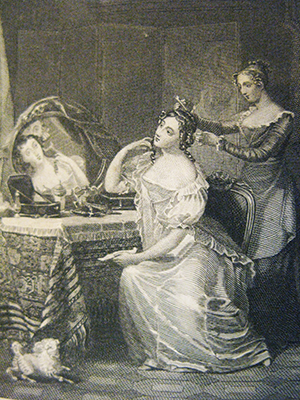With the final date for subscriptions fast approaching on 7 August, this is your last chance to become a subscriber to ‘The Duties of a Lady’s Maid’!
 ‘I have just been thinking of Betty’s sister, my dear. I should be very glad to get her so good a mistress. But whether she would do for a lady’s maid, I am sure I can’t tell.’ Jane Austen’s Mrs Jennings, Sense and Sensibility, 1811
‘I have just been thinking of Betty’s sister, my dear. I should be very glad to get her so good a mistress. But whether she would do for a lady’s maid, I am sure I can’t tell.’ Jane Austen’s Mrs Jennings, Sense and Sensibility, 1811
Betty’s sister may have benefited from a conduct book for ladies’ maids, with instructions on how to please her mistress in such a role. One of the treasured works in our library collection, The Duties of a Lady’s Maid: with directions for conduct and numerous reciepts for the toilette (1825), is a fascinating example of such a book. It certainly makes clear that an early nineteenth-century lady’s maid served under numerous expectations and pressures: to her mistress she had to be a beautician, dresser, fashion guru, tactful advisor and trusted confidante, whilst always remembering her place and precarious position, never entertaining dangerous illusions of equality. This autumn, Chawton House Library will be producing a facsimile version of this title, which provides a unique insight into the place of the servant in the English past.

In 1796, Frances Burney published her novel ‘Camilla, or, a Picture of Youth’ by subscription. Amongst the list of subscribers was a ‘Miss J. Austen, Steventon’
The book will be published by subscription, a method of publication supported by Jane Austen herself. Austen only had her name in print twice in her lifetime—on both occasions as a book ‘subscriber’. One can only imagine the pleasure that this budding author had when seeing her name in print and this is a unique opportunity to join the same literary tradition as ‘Miss J. Austen, Steventon’ by subscribing—or purchasing a subscription for a friend.
The book is complete with a new introduction by Professor Mary Ann O’Farrell, Texas A&M University. Below is an exclusive sneak preview:
‘The real women who were ladies’ maids—neither fantasies of devotion nor nightmares of manipulation—may be harder now to construe than the visions of them we have acquired through their representations in television, novel, and film. We might be tempted to imagine them in looking at this volume, an advice book and practical resource published anonymously in 1825 for an earlier generation of ladies’ maids. Perhaps we may be able to do so. Though The Duties of a Lady’s Maid is idealizing in its own way—and though reading it is a delight—it nevertheless reveals something about the expectations under which the lady’s maid served, pressures she dealt with daily and under which may have been formed some of the contradictory elements present in her popular image today, whether we think of her as Bates or Braithwaite, Wilson or Roberts, MacEachran or O’Brien.’
